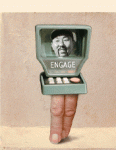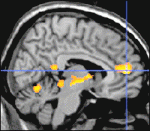Dec 05, 2005
HCI 2006: Engage!
Via Usability news
11-15 September 2006
Queen Mary, University of London
The 20th British HCI Group conference in co-operation with ACM.

From the conference's website:
This year Volume 1 papers will printed as usual, and for the first time will be published electronically with the cooperation of the ACM, see www.acm.org
In line with changes in our field, we are putting an emphasis on useful and usable research. The British HCI conference is an international forum for academics and practitioners interested in how people and technology work together. We are making no distinction between practitioners and researchers. So we say, "Farewell, Industry Day -just come for the people and the ideas"
First deadline: 3rd February, 2006
The six themes have been developed in consultation with members of the HCI community. Submissions to the conference should engage with one of the themes below and respond to the theme?s question so that the sessions at the conference can foster lively and challenging debate. There are many ways to cut each category - theories, practice, novel interaction paradigms, and so on - our aim is to bring together different points of view on each topic for lively and coherent discussion at the conference.
1. Enthralling experiences: what draws people in?
- Performance, aesthetics, emotion, and creativity: powerful engagement can be a means or an end.
2. Interactions in the wild: how does technology breach boundaries?
- The border between chaos and control changes as interactions leave the desktop and go mobile.
3. Connecting with others: what happens around and through technology?
- Interacting with colleagues and friends is helped and hindered by the connecting technology.
4. Mind, body, and spirit: how does diversity impact?
- People are different, so interactions should span age, ability, culture and gender.
5. Interactions for me: what improves my experience?
- Technology can be dehumanising but it can also improve working and social life enormously.
6. At the periphery: how can we create ambient engagement?
- Disappearing technologies, such as ubicomp, mixed media, and ambient intelligence, still engage us even though we can?t directly interact withÿthem.
HCI 2006: Engage will be hosted by Queen Mary, University of London drawing on the eclectic mix of communities and practises of the East End of London to inspire an inter-disciplinary meeting of minds.
19:09 Posted in Positive Technology events | Permalink | Comments (0) | Tags: Positive Technology
Misuse and Abuse of Interactive Technologies
"Misuse and Abuse of Interactive Technologies" CHI 2006 Workshop Date: Saturday, April 22 (Full day) Venue: Montreal, Canada, http://www.chi2006.org/
Submission Deadline: January 10
From the event's web site:
The purpose of this interdisciplinary workshop is to explore interactive systems as targets and medium of disinhibited behavior. The goal is to bring together researchers who have encountered instances of negative user behaviors in HCI, who might have given some thought to why and how such behaviors happen, and who have some ideas on how pro-active, agent based interfaces, should respond. Workshops discussions should provide a foundation for understanding the misuse and abuse of interactive technologies and for developing a systematic approach to designing interfaces that counter negative behaviors.
Some of the larger questions and issues we hope to address during the workshop are the following: - How does the misuse and abuse of the interface affect the user's computing experience? - How do different interface metaphors (embodied conversational characters, windows, desktops) shape a propensity to misuse or abuse the interface? - What design factors trigger or restrain disinhibited behaviors? - How does computer-mediated abuse differ from other forms of abuse, e.g., the abuse of people, symbols, flags sacred objects, and personal property? Is it appropriate to use the term abuse in this context? - Putdowns and other forms of verbal abuse are a part of our everyday social world. It is something we try to diffuse and avoid. How can we develop embodied conversational characters that learn to constrain users who engage in verbal abuse? Do we even need to diffuse it? - Is the act of verbally abusing a conversational agent anti-social behavior or is it the expression of social norms reflecting an asymmetric power distribution where the user is the master and the agent the slave?
As the workshop is intended to be interdisciplinary, we hope the questions and methodologies discussed will be of interest to a broad audience, including social scientists, psychologists, computer scientists, and those involved in the game industry. To help inform our questioning, we also welcome philosophical and critical investigations into the misuse and abuse of computing artifacts.
Prospective participants should send a 2/4-page position paper (following the CHI extended Abstract format www.chi2006.org/ceaf.php) to Antonella.de-angeli@manchester.ac.uk.
Further information on the workshop can be found at www.agentabuse.org.
18:57 Posted in Positive Technology events | Permalink | Comments (0) | Tags: Positive Technology
Dec 04, 2005
Dementia and Caregiver Quality of Life
Via Brain Blog
Thomas P, Lalloue F, Preux PM, Hazif-Thomas C, Pariel S, Inscale R, Belmin J, & Clement JP. Dementia patients caregivers quality of life: The PIXEL study. International Journal of Geriatric Psychiatry. 2005 Dec 2; [Epub ahead of print]
University Department of Psychogeriatrics & Memory Clinic CH Limoges, France.
14:10 Posted in Brain training & cognitive enhancement | Permalink | Comments (0) | Tags: Positive Technology, Cognitive prosthetics
Post Doctoral Proposal on Virtual Reality and 3D Interaction
Via VRPSYCH mailing list
A one year post-doc position is available at INRIA in Grenoble on VR and 3D interaction.
The candidate should have defended his PhD less than 1 year ago and should have an excellent CV.
The post-doc is available "immediately".
For more information, contact as soon as possible:
Sabine Coquillart
Sabine.Coquillart@inria.fr
Tel: +33 (0)4 76 61 52 65
11:30 Posted in Research institutions & funding opportunities | Permalink | Comments (0) | Tags: Positive Technology
Dec 02, 2005
Ecstasy exibition: in and about altered states
 Ecstasy presents recent and specially commissioned works that challenge notions of interactivity while generating a heightened aural and visual experience for the individual. Featured artists include Franz Ackermann, Eija-Liisa Ahtila, Francis Alÿs, Chiho Aoshima, assume vivid astro focus, Massimo Bartolini, Tatsurou Bashi, Glenn Brown, Janet Cardiff and Georges Bures Miller, Olafur Eliasson, Lara Favaretto, Sylvie Fleury, Tom Friedman, Rodney Graham, Jeppe Hein, Carsten Höller, Pierre Huyghe, Ann Veronica Janssens, Ann Lislegaard, Matt Mullican, Takashi Murakami, Paul Noble, Roxy Paine, Charles Ray, Erwin Redl, Pipilotti Rist, Paul Sietsema, Fred Tomaselli, and Klaus Weber. The exhibition is organized by Chief Curator Paul Schimmel with Gloria Sutton and is accompanied by a fully illustrated catalogue.
Ecstasy presents recent and specially commissioned works that challenge notions of interactivity while generating a heightened aural and visual experience for the individual. Featured artists include Franz Ackermann, Eija-Liisa Ahtila, Francis Alÿs, Chiho Aoshima, assume vivid astro focus, Massimo Bartolini, Tatsurou Bashi, Glenn Brown, Janet Cardiff and Georges Bures Miller, Olafur Eliasson, Lara Favaretto, Sylvie Fleury, Tom Friedman, Rodney Graham, Jeppe Hein, Carsten Höller, Pierre Huyghe, Ann Veronica Janssens, Ann Lislegaard, Matt Mullican, Takashi Murakami, Paul Noble, Roxy Paine, Charles Ray, Erwin Redl, Pipilotti Rist, Paul Sietsema, Fred Tomaselli, and Klaus Weber. The exhibition is organized by Chief Curator Paul Schimmel with Gloria Sutton and is accompanied by a fully illustrated catalogue.18:51 Posted in Cyberart | Permalink | Comments (0) | Tags: Positive Technology
Dec 01, 2005
Characterization of four-class motor imagery EEG data for the BCI-competition 2005
J Neural Eng. 2005 Dec;2(4):L14-22
Authors: Schlögl A, Lee F, Bischof H, Pfurtscheller G
To determine and compare the performance of different classifiers applied to four-class EEG data is the goal of this communication. The EEG data were recorded with 60 electrodes from five subjects performing four different motor-imagery tasks. The EEG signal was modeled by an adaptive autoregressive (AAR) process whose parameters were extracted by Kalman filtering. By these AAR parameters four classifiers were obtained, namely minimum distance analysis (MDA)-for single-channel analysis, and linear discriminant analysis (LDA), k-nearest-neighbor (kNN) classifiers as well as support vector machine (SVM) classifiers for multi-channel analysis. The performance of all four classifiers was quantified and evaluated by Cohen's kappa coefficient, an advantageous measure we introduced here to BCI research for the first time. The single-channel results gave rise to topographic maps that revealed the channels with the highest level of separability between classes for each subject. Our results of the multi-channel analysis indicate SVM as the most successful classifier, whereas kNN performed worst.
23:15 Posted in Brain-computer interface | Permalink | Comments (0) | Tags: Positive Technology, brain-computer interface
A wavelet-based time-frequency analysis approach for classification of motor imagery for brain-computer interface applications
J Neural Eng. 2005 Dec;2(4):65-72
Authors: Qin L, He B
Electroencephalogram (EEG) recordings during motor imagery tasks are often used as input signals for brain-computer interfaces (BCIs). The translation of these EEG signals to control signals of a device is based on a good classification of various kinds of imagination. We have developed a wavelet-based time-frequency analysis approach for classifying motor imagery tasks. Time-frequency distributions (TFDs) were constructed based on wavelet decomposition and event-related (de)synchronization patterns were extracted from symmetric electrode pairs. The weighted energy difference of the electrode pairs was then compared to classify the imaginary movement. The present method has been tested in nine human subjects and reached an averaged classification rate of 78%. The simplicity of the present technique suggests that it may provide an alternative method for EEG-based BCI applications.
23:15 Posted in Brain-computer interface | Permalink | Comments (0) | Tags: Positive Technology, brain-computer interface
Game to teach street crossing safety
From The Birmingham News
When pilots learn to fly and surgeons to cut, virtual reality comes in handy where blunders can be fatal.
Learning to cross the street is no different, so David Schwebel, associate professor of psychology at UAB, is developing a virtual reality game to teach school children how to cross safely. Of 4,641 pedestrians who died nationwide last year, 363 were 14 and younger, according to the National Highway Traffic Safety Administration...
read the full article here
23:10 Posted in Cybertherapy | Permalink | Comments (0) | Tags: serious gaming, cybertherapy
Nov 30, 2005
BrainML project
One such extension is provided by the new NIH-supported neuroinformatics initiative of the Society for Neuroscience, which supports the development of expert-derived terminology sets for several areas of neuroscience. Under a cooperative agreement, these term lists will be made available Open Source.
This site provides a complete description of BrainML, and it also serves as a public repository of BrainML models.
23:30 Posted in Research tools | Permalink | Comments (0) | Tags: Positive Technology, research tools
Influence of imagined posture and imagery modality on corticospinal excitability
Behav Brain Res. 2005 Nov 25
Authors: Fourkas AD, Ionta S, Aglioti SM
23:25 Posted in Mental practice & mental simulation | Permalink | Comments (0) | Tags: Positive Technology, mental practice, motor imagery
Nov 29, 2005
11th Annual CyberTherapy Conference
The Interactive Media Institute and the Cyberpsychology Lab of the UQO announce the first call for abstracts for CyberTherapy 11. The submission deadline is February 20th 2006.
Guest speaker: Pierre-Gilles de Gennes, Nobel Prize of Physics in 1991
Tentative title of his talk: Contributions of Physics to Medicine
Preconference Workshops: June 12th, 2006
Conference: June 13th - 15th, 2006, Gatineau (Province of Quebec, Canada)
Cyberarium : June 13th, 2006
Submission and Registration Deadlines: February 20th, 2006
Submission for posters, orals and symposiums.
March 6th, 2006: Authors are informed if their submission has been accepted.
March 30th, 2006: Deadline to submit a full paper (for those interested).
April 30th, 2006: Deadline for early pre-registration (see web site for details)
Early pre-registration: 350 $ (Can), 175 $ (Can) for students.
Pre-registration: 450 $ (Can), 225 $ (Can) for students.
May 20th, 2006: Deadline to register for workshops (75 $ (Can) per workshop).
June 6th, 2006: Deadline for pre-registration (only on-site registration after that date: 500 $ (Can), 275 $ (Can) for students).
Note that abstracts will be published in a regular issue of the journal Cyberpsychology and Behavior and presentations will be available in pdf on the CT11 web site the day after the conference.
More information about the CT11 conference can be found on the Interactive Media Institute website
17:06 Posted in Positive Technology events | Permalink | Comments (0) | Tags: Positive Technology
Nov 28, 2005
Wireless care for dementia patients
Via Medical Informatics Insider
Safe at Home project has evaluated the viability and clinical effectiveness of telecare and assistive technology in supporting the independence of people with dementia.

According to the project's final report, the Safe at Home project has enabled people with dementia to remain independent for longer, receiving the care and support they need in their own homes through the use of assistive technology, and has brought the local agencies in Northamptonshire equivalent savings of over £1.5 million over the 21 months during which research took place.
Emerging from ideas developed from the EU-funded ASTRID project that was led by Northamptonshire County Council, Safe at Home began as a small-scale project in 2000, and an initial evaluation published in 2002 provided evidence that supported a decision to expand the project. A second evaluation of this larger project was undertaken from June 2002 to March 2004, and involved 233 individuals and their carers. The study aimed to assess the reliability of the assistive technology used, the extent to which it supported unpaid carers, the extent to which it supported the independence of people with dementia and the cost effectiveness of the technology.
20:10 Posted in Brain training & cognitive enhancement | Permalink | Comments (0) | Tags: Positive Technology, Cognitive prosthetics
Nominate Positive Technology for the Medical Weblog Award!
Medgadget has announced the second annual Medical Weblog Awards. These awards are designed to honor the very best in the medical blogosphere, as decided by the readers.

The categories for this year's awards will be:
-- Best Medical Weblog
-- Best New Medical Weblog (established in 2005)
-- Best Literary Medical Weblog
-- Best Clinical Sciences Weblog
-- Best Health Policies/Ethics Weblog
-- Best Medical Technologies/Informatics Weblog
Nominations are now accepted here.
This will help the PT community to grow up and gain more visibility.
I remind all readers that Positive Technology is a not-for-profit initiative for disseminating the applications of interactive technology in mental health and well-being.
16:56 Posted in Positive Technology events | Permalink | Comments (0) | Tags: Positive Technology
Disruptive Innovations in Healthcare Conference
The Healthcare Innovation and Convergence Summit (Health IC) focuses on the most disruptive innovations occurring today, showcases the business and convergence opportunities, presents a roadmap for the future, and provides a forum specifically geared towards matching today’s most innovative new companies with investors and developers.
A two-day, four-track conference program of seminars, panels and roundtables covers new science, technology and business approaches in regenerative medicine, innovative patient care, and medical informatics.
More information on the conference website
15:28 Posted in Positive Technology events | Permalink | Comments (0) | Tags: Positive Technology
60 seconds trip
15:00 Posted in Cyberart | Permalink | Comments (0) | Tags: Positive Technology
Nov 26, 2005
EMG Activity in Selected Target Muscles During Imagery Rising on Tiptoes in Healthy Adults and Poststroke Hemiparetic Patients
Authors: Dickstein R, Gazit-Grunwald M, Plax M, Dunsky A, Marcovitz E
The authors sought to gain further knowledge about activation of target muscles during imagery engagement in a motor task. Six hemiparetic patients and 9 healthy participants performed 3 real rises on tiptoes and then, after pausing, 3 imagery rises on tiptoes. Metronome beats guided the rate of rises and descents. Electromyographic (EMG) activity from the medial gastrocnemius and the rectus femoris muscles were monitored bilaterally throughout the performance of both tasks. In 3 healthy participants and 3 individuals with hemiparesis, EMG activity was related to the imagery task in at least 1 of the target muscles. Conversely, in the other participants, motor imagery practice was not accompanied by task-related EMG activity in the monitored muscles. In all cases, the increment in activation level during motor imagery practice was very low in comparison with that of real performance. The findings were not unequivocal; therefore, EMG activity may sometimes, but not always, be recorded during motor imagery practice both in healthy individuals and in poststroke hemiparetic participants. Further research is needed to align motor imagery practice with the objectives of motor rehabilitation.
11:55 Posted in Mental practice & mental simulation | Permalink | Comments (0) | Tags: Positive Technology, mental practice, motor imagery
Nov 23, 2005
CHI 2006 Workshop: Designing for Collective Remembering - Montreal, Canada
Via Usability News
Event Date: 23 April 2006 to 23 April 2006
Venue: Montreal, Canada
Dates: 23 April 2006
We invite position papers for the CHI 2006 Workshop entitled “Designing for Collective Remembering”. While much research has focused on capturing and sharing personal memories, less work has addresses collective memories and their remembrance. When memories relate to significant events impacting on an entire group or community and are shared amongst that group, they become collective. Such memories are usually rich, emotionally charged, better recalled by groups and can enhance the group’s sense of identity.
This one-day workshop will offer an interdisciplinary forum of discussion for practitioners interested in designing technology for collective remembering and academic researchers in fields such as design, HCI, computer science, sociology, anthropology and information science. The workshop will facilitate discussions aimed at the development of a set of guidelines for designing systems for collective remembering. This includes designing for the experience of sharing one’s own memories, and for the experience of enjoying others’ memories.
Submissions in the form of four page position papers describing case studies of fully developed or prototype systems for collective remembering should be sent by December 18 to Corina Sas at c.sas AT lancaster.ac.uk. Theoretical approaches to design challenges for collective memories are also welcomed. Participants will be selected on the basis of the originality of their position paper and contribution to the workshop goals. The workshop will be organised as brief individual presentations, problem-based group learning activities, group presentation and full-group discussion of results.
More info under this link
16:09 Posted in Positive Technology events | Permalink | Comments (0) | Tags: Positive Technology
VR training for safe street crossing of neglect patients
Disabil Rehabil. 2005 Oct 21;27(20):1235-44
Authors: Katz N, Ring H, Naveh Y, Kizony R, Feintuch U, Weiss PL
Abstract. Purpose. The goal of this study was to determine whether non immersive interactive virtual environments are an effective medium for training individuals who suffer from Unilateral Spatial Neglect (USN) as a result of a right hemisphere stroke, and to compare it to a standard computer visual scanning training.Method. Participants included 19 patients with right hemisphere stroke in two groups, 11 in an experimental group were given computer desktop-based Virtual Reality (VR) street crossing training and 8 in a control group who were given computer based visual scanning tasks, both for a total of twelve sessions, 9 hours total, over four weeks. Measures included: 1. Standard USN assessments, paper and pencil and ADL checklist; 2. Test on the VR street program; and 3. Actual street crossing videotaped. Testing was performed pre and post intervention.Results. The VR group achieved on the USN measures results that equaled those achieved by the control group treated with conventional visual scanning tasks. They improved more on the VR test and they did better on some measures of the real street crossing.Conclusions. Despite several limitations in this study the present results support the effectiveness of the VR street program in the treatment of participants with USN, and further development of the program.
16:05 Posted in Cybertherapy | Permalink | Comments (0) | Tags: Positive Technology, virtual reality
Hypnosis can stop Stroop effect
Via Neurodudes
A new experiments by Raz et al., recently published in the Proceedings of the National Academy of Science, found that hypnotic suggestion affects cognitive control by modulating activity in specific brain areas, namely visual areas and the anterior cingulate cortex, which is involved in conflict monitoring.

Raz et al. Hypnotic suggestion reduces conflict in the human brain, Proceedings of the National Academy of Sciences 2005;
Abstract: Many studies have suggested that conflict monitoring involves the anterior cingulate cortex (ACC). We previously showed that a specific hypnotic suggestion reduces involuntary conflict and alters information processing in highly hypnotizable individuals. Hypothesizing that such conflict reduction would be associated with decreased ACC activation, we combined neuroimaging methods to provide high temporal and spatial resolution and studied highly and less-hypnotizable participants both with and without a suggestion to interpret visual words as nonsense strings. Functional MRI data revealed that under posthypnotic suggestion, both ACC and visual areas presented reduced activity in highly hypnotizable persons compared with either no-suggestion or less-hypnotizable controls. Scalp electrode recordings in highly hypnotizable subjects also showed reductions in posterior activation under suggestion, indicating visual system alterations. Our findings illuminate how suggestion affects cognitive control by modulating activity in specific brain areas, including early visual modules, and provide a more scientific account relating the neural effects of suggestion to placebo.
16:00 Posted in Meditation & brain | Permalink | Comments (0) | Tags: Positive Technology, meditation
The Health e-Technologies Initiative
The Health e-Technologies Initiative is a $10.3-million National Program Office of The Robert Wood Johnson Foundation. The program of funded research aims to advance the discovery of scientific knowledge regarding the effectiveness of interactive applications (i.e., Internet, interactive TV and voice response systems, kiosks, personal digital assistants, CD-ROMs, DVDs) for health behavior change and chronic disease management.

Link to the initiative
15:22 Posted in Research institutions & funding opportunities | Permalink | Comments (0) | Tags: Positive Technology







